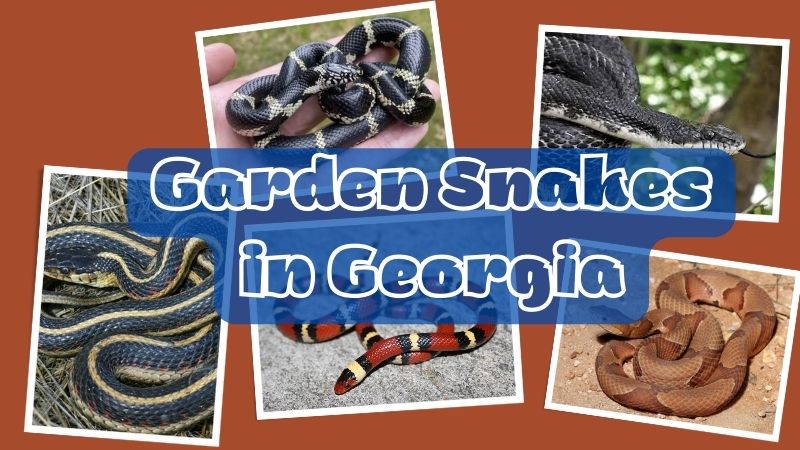Georgia, with its diverse ecosystem, is home to many different species of snakes. For those who garden and live here, identifying and understanding garden snakes in Georgia is important to ensure the safety and protection of natural habitats. In this article, Garden Creatives will learn about common garden snakes in Georgia, how to identify them, and safety measures when encountering snakes.
What are Garden Snakes in Georgia?
Garden snakes in Georgia is a term used to refer to snakes that commonly appear in gardens, parks, and residential areas in the state of Georgia, United States. Georgia has a natural environment rich with many different types of snakes, including both venomous and non-venomous. Understanding these snakes is important to ensure human safety and maintain ecological balance.
Common Characteristics of Garden Snakes in Georgia
1. Species Diversity
Georgia is home to many different snake species, from non-venomous species such as the Eastern King Snake and Scarlet Kingsnake to venomous species such as the Copperhead and Rattlesnake.
2. Living Environment
Garden snakes in Georgia often live in areas with lots of grass, bushes, and leaf litter, and near water sources such as ponds, lakes, and streams. These areas provide ideal habitat with plenty of food and shelter.
3. Role in the Ecosystem
Snakes play an important role in garden ecosystems by controlling populations of small animals such as mice, insects, and other rodents. They help maintain biological balance and minimize the spread of animal-borne diseases.
Common Garden Snakes in Georgia
1. Eastern King Snake
Identifying Characteristics: Eastern king snakes are black with white or yellow stripes, forming circular patterns around the body. They are usually from 90 cm to 1.2 m long.
Behavior: This snake is non-venomous and often eats other snakes, including venomous snakes.
Habitat: They often live in forest areas, grasslands, and home gardens.
2. Scarlet Kingsnake
Identifying Characteristics: Scarlet milk snakes are colorful red, black, and yellow, with alternating color bands. They are usually between 30 cm and 70 cm long.
Behavior: This snake is non-venomous and very shy.
Habitat: They like to live in areas with many layers of fallen leaves and under piles of rotten wood.
3. Copperhead
Identifying Characteristics: Copperhead snakes are brown in color with hourglass-shaped black lines on their back. They are usually between 60 cm and 90 cm long.
Behavior: This is a venomous snake, but is usually not fatal to humans. However, their bite is very painful.
Habitat: Copperheads like to live in wet areas, near streams or lakes.
4. Black Rat Snake
Identifying Characteristics: The black rat snake is jet black in color, with a long and thin body. They can be up to 1.8 m long.
Behavior: Non-venomous and very gentle, black rat snakes help control the rat population.
Habitat: They are often found in forests, fields, and areas around houses.
5. Eastern Garter Snake
Identifying Characteristics: Black-striped snakes have long and thin bodies, with yellow or white stripes running along the length of the body. They are usually between 45 cm and 65 cm long.
Behavior: This is a non-venomous snake that usually eats insects, frogs, and small fish.
Habitat: Black-striped snakes like to live in wet areas, near water sources such as ponds, lakes, and streams.
The Importance of Snakes in the Ecosystem
Snakes play an important role in the ecosystem, helping to maintain biological balance by controlling populations of small animals such as mice, insects, and other rodents. They are also part of the food chain, serving as a food source for larger animals such as birds of prey and other carnivores. The presence of snakes in the garden helps protect crops and minimizes the use of pesticides.
Safety Measures When Encountering Snakes
Keep Your Distance: If you see a snake, keep a safe distance and do not try to approach or catch it.
Do Not Agitate: Avoid making the snake feel threatened. Snakes usually only attack when they feel in danger.
Use Protection Tools: When gardening, wear tall boots, gloves, and long pants to reduce the risk of snake bites.
Keep Your Garden Clean: Remove fallen leaves, weeds, and piles of wood so snakes have nowhere to hide.
Seek Help: If you encounter a venomous snake or are unsure about the snake species, contact a wildlife expert for help.
First Aid Instructions for Snake Bites
Stay Calm: Try to stay calm and don’t move too much to limit the spread of venom.
Call Emergency: Contact emergency medical services immediately for timely assistance.
Clean the Wound: Clean the bite site with soap and water, but do not apply ice or a tight bandage.
Take the Bitten Person to the Hospital: Quickly take the bitten person to the nearest medical facility for professional treatment.
Important Notes
Identifying Venomous and Non-Poisonous Snakes: Identifying venomous and non-venomous snakes is important to be able to handle the situation safely. In addition to copperheads, Georgia also has other venomous snakes such as the Eastern Coral Snake and the Eastern Diamondback Rattlesnake. Learn about their identifying characteristics to ensure the safety of you and your family.
Respect Snakes and Their Habitat: Snakes play an important role in maintaining ecological balance. Unnecessary killing or removal of snakes can have a negative impact on the environment. Instead, try to safely relocate the snake or call a professional for assistance.
Family Snake Safety Training: Make sure everyone in the family, especially children, knows how to identify and respond to snakes. Teach them how to stay calm, avoid provoking snakes, and notify an adult if they see a snake in the area.
Conclude
garden snakes in Georgia play an important role in the ecosystem, helping to control rodents and insect pests. Understanding common garden snakes in Georgia and how to deal with them will help you protect yourself and your family while maintaining a natural balance in your garden. Always be careful and respect the presence of these wild animals to live together in harmony.





